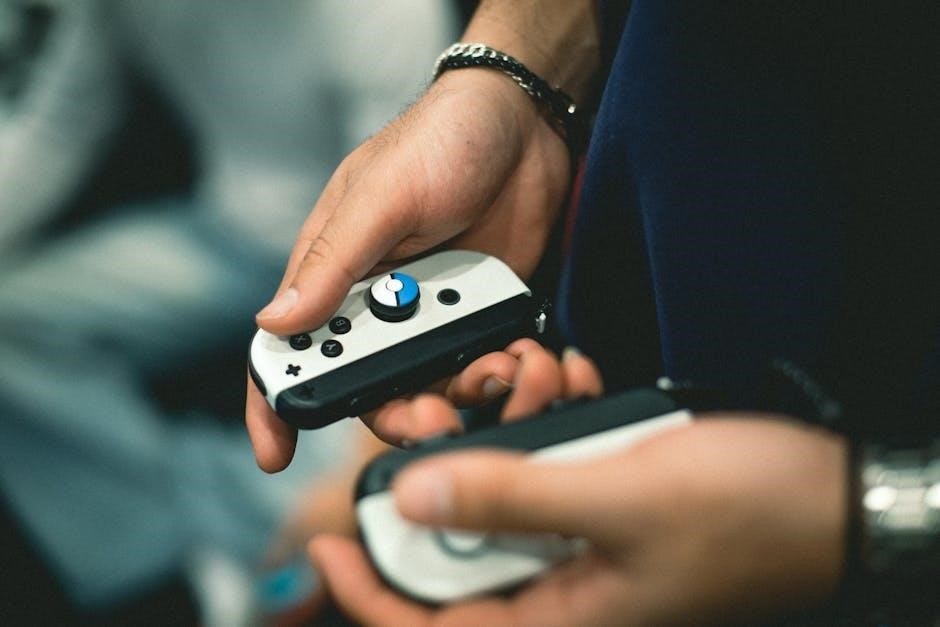Brivis evaporative cooling systems have provided Australian families with climate control for over 50 years. These systems work best in dry conditions, drawing fresh air through cooling pads. Brivis controllers, like the NC6, let users manage fan and pump settings.

Understanding Your Brivis Controller
Brivis offers a range of controllers, from the basic manual models to the advanced Touch Controller. These controllers manage heating, cooling, and zoning. Knowing your controller model is important, as functionality varies; Manuals are available for download on the Brivis website for support.
Identifying Your Brivis Controller Model
Identifying your Brivis controller model is crucial for accessing the correct manual and troubleshooting information. Different models have varied features and operational procedures. One common model is the NC6, but older units may have different designs and functionalities. Check the controller’s faceplate or housing for a model number, often located near the Brivis logo or on a sticker.
If you can’t find the model number there, consult the original installation documentation or the system’s manuals. These documents usually specify the controller model installed with your Brivis system. You might also find the model information on the unit itself.
If these resources are unavailable, compare your controller’s appearance with images online or in Brivis manuals to identify it visually. Brivis’ website and online forums can be helpful. Contacting Brivis directly with a photo might also lead to identification. Knowing the model ensures you use the right manual for operation, maintenance, and troubleshooting.

Manual Operation of Brivis Evaporative Cooling
To manually operate your Brivis evaporative cooler, activate the controller, select EVAP mode, and turn the system on. Manual control allows adjusting the fan speed and pump settings to your desired comfort level, bypassing automatic functions.
Activating Manual Mode
To engage manual operation on your Brivis evaporative cooling system, begin by activating the wall controller. This is usually achieved by pressing the ON/OFF button. Once the controller is active, navigate to the mode selection. On most Brivis controllers, including the NC6 model, this involves pressing the “Mode” button until “Manual” or “MAN” is displayed on the screen.
Confirm that the system is in evaporative cooling mode (“EVAP”) before proceeding. If your controller combines heating and cooling, you may need to select “EVAP” using the mode button. After the correct mode is selected, you will need to press the “Auto” button to disengage auto mode. The display should then indicate that the system is in manual mode.
Once the manual mode is active, you gain direct control over the fan speed and pump operation. This will override any programmed settings or automatic adjustments. This can be useful if you want to test the system, or if you’re having trouble with automatic mode. Remember to make sure windows and doors are open!
Adjusting Fan Speed and Pump Settings Manually
Once manual mode is active on your Brivis evaporative cooler, you can fine-tune the fan speed and pump settings to achieve your desired comfort level. Typically, fan speed adjustment is managed via a rotary dial or dedicated up/down buttons on the controller. Rotating the dial or pressing the buttons will increase or decrease the fan’s intensity. This allows precise control over the airflow and cooling effect.
For pump control, many Brivis controllers offer a separate button to toggle the pump on or off. Ensure the pump is activated to wet the cooling pads for evaporative cooling. When the pump is off, only the fan will operate, providing ventilation without cooling. It’s important to note that optimal cooling occurs when both the fan and pump are running.
Experiment with different fan speeds and pump combinations to determine the settings that best suit your needs and weather conditions. Keep in mind that evaporative coolers work best on hot, dry days. Regularly monitor the system’s performance and adjust settings as needed to maintain a comfortable indoor environment. Remember to provide good ventilation, by opening windows and doors.

Troubleshooting Common Controller Issues
Common controller issues include display problems, often solved by battery replacement. Resetting the controller can resolve operational glitches. Consult your Brivis manual for model-specific troubleshooting steps. For more assistance, contact a Brivis stockist for expert advice.
Controller Display Problems and Battery Replacement
Encountering display issues with your Brivis controller is a common problem, often indicated by a faded or completely blank screen. The primary culprit is usually depleted batteries. Replacing the batteries in your Brivis wall controller can often restore the display to its normal functionality. Before replacing them, ensure you purchase the correct type, as specified in your Brivis evaporative cooling manual.
If the display remains dim or unresponsive after replacing the batteries, try cleaning the battery contacts within the controller. Use a dry cloth or cotton swab to gently remove any corrosion or debris that may be hindering proper contact. If this doesn’t solve the problem, consult your manual or contact Brivis support.
In some cases, persistent display problems may indicate a more significant issue with the controller itself. If all troubleshooting steps fail, it might be necessary to consider a controller replacement to ensure optimal system operation.
Resetting Your Brivis Wall Controller
If you’re experiencing issues with your Brivis evaporative cooling system, such as unresponsive controls or incorrect readings, resetting your wall controller can often resolve these problems. A reset effectively restarts the controller, clearing any temporary glitches or errors that may be affecting its performance.
The reset procedure can vary depending on the specific model of your Brivis controller, so consult your user manual for precise instructions. Generally, it involves either pressing a dedicated reset button (often located on the back or side of the controller) or disconnecting the power supply for a short period.
After performing the reset, the controller may need to be reprogrammed with your desired settings, such as temperature preferences and zone configurations. Refer to your Brivis manual for guidance on how to reconfigure these settings. If the reset doesn’t resolve the issue, further troubleshooting or professional assistance may be required.
Brivis Evaporative Cooling Maintenance
Maintaining your Brivis evaporative cooling system is crucial for ensuring its optimal performance, energy efficiency, and longevity. Regular maintenance helps prevent issues and keeps your system running smoothly, especially during peak cooling seasons. A key aspect of maintenance is regularly checking and cleaning the filter pads. These pads trap dust, pollen, and other airborne particles, which can reduce airflow and cooling effectiveness if left unaddressed.
Depending on your environment, cleaning or replacing the pads may be necessary every few months. Additionally, inspect the water distribution system for any clogs or mineral buildup, ensuring even water flow across the pads. Periodically check the pump and fan for proper operation, listening for unusual noises or vibrations that may indicate a problem. Finally, ensure that the unit’s vents and openings are clear of debris and obstructions. Regular maintenance not only extends the lifespan of your system but also ensures clean and healthy air circulation throughout your home.

Understanding Auto Mode vs. Manual Mode
Brivis evaporative cooling systems offer both Auto and Manual modes, providing different levels of control over your home’s cooling. Auto mode is designed for convenience and efficiency. In this mode, the system automatically adjusts fan speed and pump operation based on temperature and humidity sensors. This ensures consistent comfort while optimizing energy consumption. The system intelligently pre-wets the pads before the fan starts to provide instant cooling.
Manual mode, on the other hand, gives you direct control over the fan speed and pump settings. This allows you to customize the cooling output to your preferences, regardless of the ambient conditions. You can adjust the fan speed to achieve the desired airflow and control the pump to manage the moisture level. While Manual mode offers greater flexibility, it requires more active management to avoid overcooling or wasting water. Understanding the benefits of each mode allows you to choose the best option for your needs and maximize your Brivis system’s performance.
Downloading Brivis Manuals and Support Resources
Accessing the correct Brivis manuals and support resources is crucial for understanding your evaporative cooling system and resolving any issues that may arise. Official manufacturer’s systems manuals for Brivis gas ducted heaters, add-on coolers, and evaporative coolers are readily available online. You can download these manuals to your computer or mobile device for easy access. These manuals offer detailed information on operation, maintenance, and troubleshooting.
If you’ve misplaced your Brivis heater or cooler owner’s guide, you can easily download a copy from the Brivis website. In addition to manuals, Brivis provides various support resources, including FAQs, troubleshooting guides, and contact information for local stockists. These resources can help you find the right advice and products for your system. Check the Brivis website for product specification sheets, brochures, and installation guides. For technical assistance, you can contact Brivis directly or consult a qualified technician.
Warranty Information for Brivis Coolers
Understanding the warranty coverage for your Brivis cooler is essential for protecting your investment and ensuring peace of mind. The Brivis cooler is covered by a product warranty, the specifics of which are outlined in the product manual. This warranty typically covers defects in materials and workmanship under normal use and conditions. It is important to carefully review the warranty terms and conditions to understand the scope of coverage, any exclusions, and the procedure for making a claim.
The warranty period may vary depending on the specific model and components of your Brivis cooler. Keep your purchase receipt and any warranty documentation in a safe place, as you will need them to make a warranty claim. If you experience any issues with your Brivis cooler during the warranty period, contact Brivis or an authorized service agent to arrange for an inspection and repair. Be sure to follow the manufacturer’s instructions for maintenance and operation to avoid voiding the warranty.
